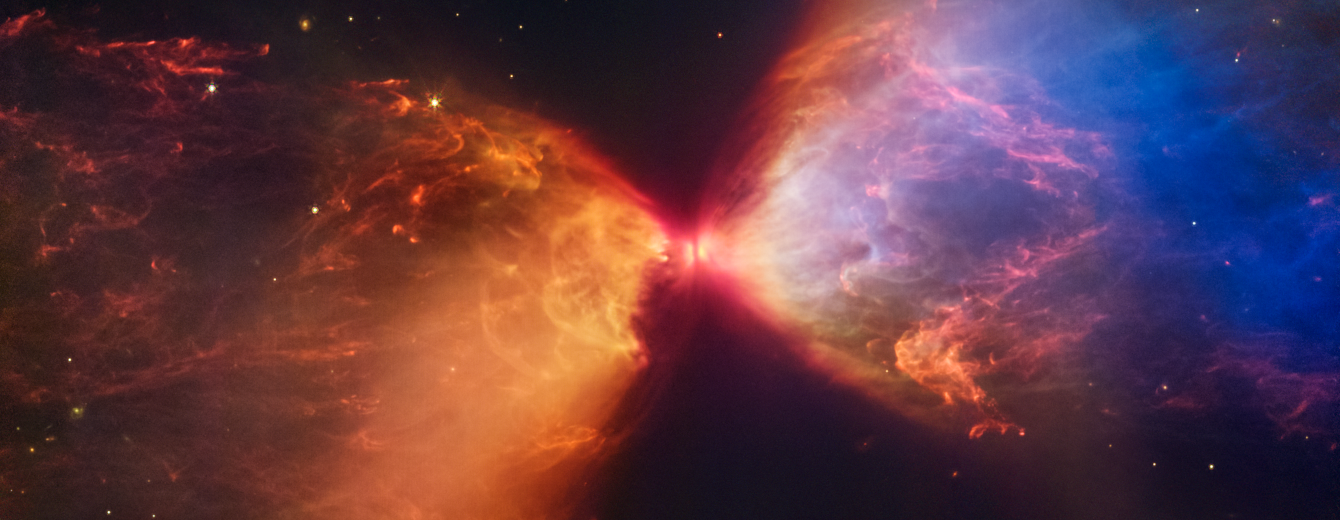NASA’s James Webb Space Telescope has exposed the once-concealed characteristics of the protostar inside the dark cloud L1527, offering new understandings concerning the birth of a new star.
 The protostar within the dark cloud L1527, shown in this image from NASA’s James Webb Space Telescope Near-Infrared Camera (NIRCam), is embedded within a cloud of material feeding its growth. Ejections from the star have cleared out cavities above and below it, whose boundaries glow orange and blue in this infrared view. The upper central region displays bubble-like shapes due to stellar “burps,” or sporadic ejections. Webb also detects filaments made of molecular hydrogen that has been shocked by past stellar ejections. The edges of the cavities at upper left and lower right appear straight, while the boundaries at upper right and lower left are curved. The region at lower right appears blue, as there’s less dust between it and Webb than the orange regions above it. Image Credit: SCIENCE: NASA, ESA, CSA, STScI; IMAGE PROCESSING: Joseph DePasquale (STScI), Alyssa Pagan (STScI), Anton M. Koekemoer (STScI)
The protostar within the dark cloud L1527, shown in this image from NASA’s James Webb Space Telescope Near-Infrared Camera (NIRCam), is embedded within a cloud of material feeding its growth. Ejections from the star have cleared out cavities above and below it, whose boundaries glow orange and blue in this infrared view. The upper central region displays bubble-like shapes due to stellar “burps,” or sporadic ejections. Webb also detects filaments made of molecular hydrogen that has been shocked by past stellar ejections. The edges of the cavities at upper left and lower right appear straight, while the boundaries at upper right and lower left are curved. The region at lower right appears blue, as there’s less dust between it and Webb than the orange regions above it. Image Credit: SCIENCE: NASA, ESA, CSA, STScI; IMAGE PROCESSING: Joseph DePasquale (STScI), Alyssa Pagan (STScI), Anton M. Koekemoer (STScI)
These blazing clouds inside the Taurus star-forming region are only noticeable in infrared light, rendering it a perfect target for Webb’s Near-Infrared Camera (NIRCam).
The protostar itself is hidden from sight within the “neck” of this hourglass shape. An edge-on protoplanetary disk is perceived as a dark line running through the middle of the neck. Light from the protostar seeps below and above this disk, irradiating cavities within the nearby gas and dust.
The most predominant features of the region are the clouds colored orange and blue in this representative-color infrared image and the profile cavities formed as material shoots away from the protostar and bumps into the adjacent matter.
The colors themselves are a result of layers of dust between Webb and the clouds. The blue regions are where the dust is the least. The thicker the layer of dust, the less blue light can seep out, forming compartments of orange.
Webb also exposes filaments of molecular hydrogen that have been shocked as the protostar expels material away from it. Shocks and turbulence obstruct the creation of new stars, which would otherwise develop all across the cloud. Consequently, the protostar dominates the space, capturing a majority of the material for itself.
Regardless of the chaos that L1527 creates, it is only approximately 100,000 years old — a fairly young body. Considering its age and its brightness in far-infrared light as seen by missions such as the Infrared Astronomical Satellite, L1527 is said to be a class 0 protostar, the first stage of star foundation.
Protostars such as these, which are still wrapped in a dark cloud of gas and dust, have a long formation journey before they turn into adult stars. L1527 does not produce its own energy via the nuclear fusion of hydrogen, which is a vital feature of stars.
Its shape, while typically spherical, is also unbalanced, taking the shape of a small, hot, and bloated clump of gas somewhere between 20 and 40% the mass of the Sun.
As the protostar continues to collect mass, its core progressively compresses and starts to reach stable nuclear fusion. The adjacent molecular cloud is composed of dense dust and gas being pulled to the center, where the protostar exists.
As the material cascades in, it twists around the center. This forms a thick disk of material, called an accretion disk, which inputs material to the protostar. As it gathers more mass and compresses further, the temperature of its center will increase, ultimately reaching the point for nuclear fusion to commence.
The disk is approximately the size of the solar system. Considering the density, it is not unusual for much of this material to cluster together — the commencements of planets. Finally, this view of L1527 offers insight into how the Sun and the solar system appeared in their formative years.